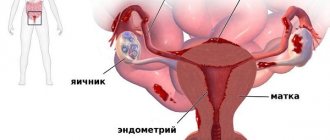Causes that do not pose a health hazard
The cause of implantation bleeding is damage to the walls of blood vessels during the implantation process. By the time the embryo moves through the fallopian tube into the uterus, it is a multicellular structure (blastocyst).
It consists of 2 types of cells:
| Cell type | Description |
| Internal (embryoplast) | These will subsequently form into an embryo. |
| External (trophoblast) | They act as a shell and ensure implantation: penetration of the embryo into the mucous membrane lining the inner walls of the uterus and anchoring in it |
If the place for implantation is chosen “unsuccessfully” and a vessel gets in the way of the chorion, its walls melt, and the contents are poured into the uterine cavity and then removed through the vagina. Outwardly, it looks like bleeding, which is the first sign of pregnancy and its normal development.
Implantation bleeding (a photo of it can be seen on the pad) is noticed by only 20% of pregnant women. More often it goes unnoticed. Its absence does not indicate pathology, but means that implantation was not accompanied by vascular damage.
The probable period of such bleeding during natural conception is the 6-7th day from the moment of fertilization. This is how long it takes for the blastocyst to enter the uterus, and for the woman’s body to create a thick layer of mucous membrane.
There are also late (on the 10th day of ovulation) and early (up to 7 days from the moment of fertilization) implantation. With early implantation, the uterine mucosa is not fully prepared and is of insufficient thickness, so the attachment will be fragile, which increases the likelihood of miscarriage. Late implantation is not dangerous.
If a woman becomes pregnant through the IVF procedure, then the likelihood of implantation bleeding is higher, and it occurs later - 8-10 days after ovulation.
This same bleeding can easily be confused with other bloody vaginal discharge that does not pose a health hazard.
Menses
Implantation bleeding (it is better to take photos of it several times, so that in case of complications it can be observed in dynamics) resembles the beginning of ordinary menstruation. In time it is also close to the date of the next menstruation.
However, there are certain differences:
| Parameter | Description |
| Deadlines | As a rule, the implantation period occurs on the 6-7th day of the expected moment of fertilization. Since the most favorable day for conception is the 14th day of the cycle, spotting due to implantation is observed approximately a week before the date of the next menstruation. In case of late implantation, bleeding may begin approximately 2 days before the expected start date of menstruation and coincide with it |
| Volume of discharge | When implanted, they are usually scanty: from a few drops to a small spot. During menstruation, the amount of blood is much greater |
| Duration | Implantation bleeding is characterized by its short duration: from several hours to 2 days. There may be breaks followed by a resumption of discharge, which are associated with a temporary cessation of the implantation process. Menstruation lasts 3-6 days, discharge is present continuously, its intensity first increases and then decreases |
| Character | The discharge associated with the implantation of the embryo is pink or brownish in color (during menstruation it is scarlet). They are watery, devoid of the specific “copper” smell characteristic of menstrual blood and do not contain clots, mucus, or lumps |
Also, menstruation is indicated by the absence of other signs of pregnancy and negative test results, which can be performed 2-3 days after the cessation of discharge.
Bleeding after failed implantation
If within 2 weeks from the moment of fertilization the embryo fails to attach to the walls of the uterus, it dies and is removed from the body. The discharge that occurs during this process is menstruation, but has its own characteristics.
They:
- more abundant, sometimes painful;
- may go with a slight delay;
- include embryonic discharge in the form of large clots that can be seen with the naked eye.
Wherein:
- there are no characteristic signs of implantation;
- the pregnancy test gives a negative result;
- The woman's genitals do not undergo changes.
Failed implantation does not indicate any pathology: according to medical statistics, in 30% of cases, biochemical pregnancy ends with successful implantation and develops further.
If multiple attempts to get pregnant end in failure at the implantation stage, then the reason may be:
- insufficient concentration of female sex hormones, under the influence of which the uterus prepares for the implantation of the embryo;
- disruption of the immune system, as a result of which it perceives the embryo as a foreign body and seeks to destroy it;
- incorrectly performed procedure or incorrectly chosen time for embryo transfer during artificial insemination;
- non-viability of the embryo;
- small thickness of the endometrium (less than 7 mm), at which the embryo cannot gain a foothold in it;
- benign tumors and inflammatory processes that deform the inner surface of the uterus.
Bloody discharge during ovulation
The release of an egg from the ovary provokes a sharp hormonal surge, which leads to a temporary increase in the permeability of the walls of blood vessels. Due to this phenomenon, a small amount of blood seeps through the walls and enters the vaginal discharge, turning it pinkish.
Differences between implantation bleeding and spotting during ovulation
The nature of the discharge during ovulation is similar to implantation bleeding, it is just as scanty and lasts 1-2 days.
However, bleeding during ovulation differs from implantation in terms of timing:
- the first - at the time of ovulation and in the next 2 days;
- the second - a week after ovulation.
Also, with bleeding caused by ovulation, there is no pain.
Microtrauma of the vaginal mucosa
Minor damage to the mucous membrane is possible:
- during sexual intercourse;
- with careless douching;
- when examined by a gynecologist.
In all these cases, a woman may find a few drops of blood on her underwear. Their appearance is not associated with pregnancy or menstruation.
This phenomenon does not pose a threat to health, provided that the bloody discharge:
- minor;
- short;
- are not accompanied by pain.
Sometimes the cause of slight bleeding after intimacy in the early stages of pregnancy is the increased sensitivity of the cervix characteristic of this period. In this case, it is necessary to refrain from sexual intercourse until a medical examination and strictly follow the recommendations of the gynecologist.
Why does bleeding occur during implantation?
Upon arrival at the uterine mucosa, the fertilized egg loses its protective layer, which leads to exposure of the trophoblast, through which the fetus is attached to the endometrium. At the same time, the trophoblast retains its important function and in the future it will take an active part in the formation of the placental membrane of the embryo.
Now as for the bleeding itself. As mentioned earlier, after fertilization of the egg, the expectant mother’s body begins to actively prepare for implantation of the embryo and its gestation. As a result, the endometrium becomes looser, cell proliferation is observed and, as a result, blood flow in the mucous tissues of the uterus increases.
During the process of attachment of the future embryo to the endometrium, some of its cells at the site of implantation are damaged. And this phenomenon is called embryonic bleeding.
This, in fact, explains the discharge after implantation. But in fact, everything looks a little different. Imagine how tiny a fertilized egg is in size and how much area it will occupy in the uterine mucosa - these are just a few millimeters.
When wondering how many days IR can last, it is worth understanding that the number of cells damaged during the attachment of the gestational egg to the wall of the uterus is so small that in the end no more than 2 drops of blood are released. And even then, not all women observe that this notorious bleeding occurs at all.
Possible diseases
Implantation bleeding (their photo is best seen on the pad) usually:
- not abundant;
- do not cause discomfort;
- painless;
- are not accompanied by deterioration in health;
- disappear quickly without treatment.
However, not all spotting is harmless: sometimes they indicate diseases or conditions that require immediate medical attention.
These are:
| State | Description |
| Ectopic (ectopic) pregnancy | A dangerous pathology in which the embryo is implanted not in the uterus, but in the fallopian tube (98% of cases). Less commonly, in the abdominal cavity, on the ovaries, on the cervix. With an ectopic pregnancy, bleeding is possible, and during the same period as with normal implantation, the pathology can be distinguished by the following symptoms:
|
| Risk of miscarriage | A condition that poses a danger to the unborn child, in which bloody discharge is also observed. You can distinguish bleeding during a threatened miscarriage from implantation bleeding by the following signs:
|
| Endometriosis | This benign growth of tissue in the uterus (endometrium) can cause bleeding. The following symptoms are present:
|
| Vaginal injuries | Serious injuries can be caused by rough sexual intercourse with several partners at once, or improper use of mechanical contraceptives or intimate accessories. In this case, heavy bleeding is possible, which is accompanied by:
|
Discharge that occurs due to the following pathologies of the female genital organs can be confused with implantation bleeding:
- background diseases of the cervix: pseudo-erosion (proliferation of the epithelium of the cervix), cervicitis (inflammation of the cervix);
- various inflammatory diseases caused by pathogens: candidiasis, bacterial vaginosis;
- the presence of benign tumors (cysts);
- hormonal dysfunction of the ovaries - disruption of their activity, leading to insufficient production of hormones, in particular estrogen, progestin and androgen;
- oncological diseases.
In all these cases, there are additional symptoms indicating trouble:
- large volume of discharge;
- accompanying pain;
- unpleasant sensations (itching, burning) in the external genital area;
- elevated body temperature.
Early warning signs of pregnancy
Due to the active formation of a new organism, characteristic physiological changes appear. Among them:
- Constant drowsiness, sleep lasts 9–12 hours.
- Unstable nervous state, irritability and tearfulness appear.
- There are taste preferences: you want sweet, sour, salty, unusual combinations of foods.
- Weakness, general malaise, severe fatigue.
- Nausea in the morning.
- Frequent urge to go to the toilet.
- Feeling of a foreign body inside, constant attempts to go to the toilet.
All these signs are not always the same; they differ from girl to girl. The characteristics do not 100% indicate the presence of new life, they only provide an additional hint if there is a delay.
Diagnostics
Implantation bleeding can be diagnosed independently if you know its main signs and carefully study it, for example, in a photo.
These include:
- scanty and short-term bleeding;
- weak nagging pain in the lower abdomen;
- mild spasms that are caused by the process of destruction of the uterine mucosa and the introduction of the embryo into it.
Also, if the basal temperature was recorded daily, then by changing its values it is possible to determine whether implantation has occurred: immediately before it it decreases to 36.8 ° C, and when the embryo is implanted, it rises again to 37 ° C.
2-3 days after the end The discharge test will show the presence of pregnancy, and the woman will be able to notice its first signs:
- fast fatiguability;
- drowsiness;
- sudden changes in mood;
- frequent urination;
- sore nipples;
- feeling of heaviness and fullness in the chest;
- sensitivity to odors;
- change in taste preferences.
These signs can also be symptoms of diseases, therefore, even with full confidence in successful implantation, it is necessary to visit a doctor a few days after the discharge stops, who will confirm or refute the self-made diagnosis.
At such early stages, no hardware method will be able to determine pregnancy, but during a visual examination, the gynecologist will notice changes in the cervix caused by an increase in the level of progesterone, a hormone that supports pregnancy.
It will be:
- color : pink before pregnancy, now it will turn bluish - this is due to the formation of new vessels and increased blood flow;
- elasticity : in its normal state the cervix is dense, after implantation it becomes soft and flexible;
- position: the neck drops slightly;
- consistency of the mucus plug , which protects the uterus from the penetration of harmful microorganisms: in its normal state the mucus is thick, during ovulation it becomes more liquid and remains so until implantation, after which it regains its thickness.
In addition, a blood test for hCG can confirm the fact of pregnancy, and after 10-12 days, when the embryo has slightly increased in size, it can be seen on the screen of an ultrasound scanner (during a transvaginal examination).
How many days does it last
The average duration of implantation bleeding is 2 hours, and the maximum is 2 days . If this period lengthens, then such bleeding can no longer be considered an indicator of normality. Prolonged bleeding may indicate the onset of a miscarriage or a hormonal imbalance.
Embryo implantation lasts from 2 hours to 2 days.
Often a woman does not notice the fact that an embryo has been implanted in her body. This happens when the discharge is scanty. Blood is simply smeared, or is present in the leucorrhoea in insignificant quantities.
When to see a doctor
Consultation with a specialist is required for any vaginal discharge, including bloody discharge. The only exception is menstrual bleeding, provided there is complete confidence that it is menstruation.
In other cases of bleeding, a visit to the antenatal clinic should take place:
- immediately, if there are symptoms indicating any disease or pathology;
- 3-4 days after the end of the discharge - with “classic” implantation bleeding (scanty, painless, short-term, starting about a week before the expected date of menstruation);
- a delay of 3-4 days is needed so that the woman’s genitals undergo the changes described above, and the level of hCG in the blood reaches the concentration at which it is already possible to diagnose pregnancy.
Also, a visit to the doctor is required in the absence of implantation bleeding and a delay in menstruation for several days, if signs of pregnancy appear, or if the test result is positive.
There is no point in postponing it, since visiting a doctor in advance gives a woman a number of advantages:
- during pregnancy - allows you to more accurately determine the date of birth, timely identify and eliminate all existing problems. Registration early is an opportunity to get a small increase in maternity leave;
- for any diseases - start their treatment at the initial stages, when it is simple, effective and least expensive;
- if an abortion is necessary, perform it using gentle methods (vacuum or medical abortion).
Treatment methods
Implantation bleeding, a photo of which helps in diagnosis, is one of the early signs of pregnancy and is considered a physiological norm. It does not require treatment provided there are no symptoms of trouble.
However, there are times when medical intervention is necessary. For example, if the implantation process is accompanied by the following symptoms:
| Symptoms | Description |
| Sharp, cutting paroxysmal pain | This may indicate that there is inflammation in the uterine cavity. Treatment consists of several stages:
Basically, drug treatment is used (antibiotics, antiviral drugs that can be used during pregnancy) and physiotherapy aimed at eliminating the inflammatory process. Surgery is performed for advanced diseases when other methods have failed |
| Severe and prolonged spasms of the uterine muscles | They also cause a feeling of tension and heaviness in the lower abdomen. Cramps in the early stages are a symptom of metabolic disorders in tissues, which significantly reduces the likelihood of a successful pregnancy. Conservative treatment is used; in extreme cases, surgical intervention is indicated. |
| Severe bloating, diarrhea, vomiting | All these symptoms are inherent in the beginning of pregnancy, but may also indicate food poisoning, which is dangerous for a pregnant woman. The patient is shown:
If home treatment is ineffective, hospitalization is performed |
A visit to a specialist is also necessary if any symptoms appear that indicate the following diseases:
- ectopic pregnancy. Treatment is performed surgically. Depending on the timing and condition of the patient, the operation removes the fertilized egg or partially/completely the reproductive organ;
- risk of miscarriage. For treatment aimed at maintaining pregnancy, hormonal, sedative and antispasmodic drugs, hemostatic agents, and vitamin complexes are used. The patient is prescribed bed rest and a strict diet. With early access to a doctor and timely treatment, the likelihood of saving the child is high;
- endometriosis (overgrowth of the endometrial walls) . The patient should be under the supervision of a doctor and drug treatment is indicated. The question of taking certain medications is decided by the doctor after a thorough examination of the patient.
Possible complications
Violations of the implantation process are possible for several reasons. Some of them are easily eliminated, others require serious treatment.
Possible factors that reduce the likelihood of further successful pregnancy include:
| Factor | Description |
| Coughing | It leads to increased pressure in the uterus, as a result of which the embryo is “forced out” of it. Implantation in this case is possible, but difficult |
| Sexual intercourse after artificial insemination | It can cause the impossibility of implantation, since the weakened embryo is negatively affected by the contractions of the muscular layer of the uterus inherent in the process |
| Incorrectly chosen date for embryo transfer during IVF | The endometrium is either not yet fully prepared, or has already begun to be rejected |
| "Implant window" | This period of time when the probability of successful implantation is maximum is 3 days (from 20 to 23 days from the beginning of the last menstruation) |
| Diseases associated with hormonal imbalance | They lead to the fact that the thickness of the endometrium may be insufficient (less than 7 mm) to secure the embryo. In this case, implantation will not occur or the risk of miscarriage will be high in the future. In addition, due to their small thickness, chorionic villi can reach the muscular layer of the uterus, causing severe and prolonged bleeding. It is believed that the optimal thickness of the endometrium, ensuring reliable attachment of the embryo, is from 7 to 14 mm |
| Immune system diseases | The body perceives the embryo as a foreign body and tries to get rid of it. For this reason, implantation is not possible |
| Inflammatory and background diseases of the uterine cavity | In the presence of tumors, the endometrium becomes lumpy, which significantly reduces the embryo’s chances of successful implantation |
| Anomalies in embryo development | It will not be able to implant or will not be viable. The risk of abnormalities incompatible with life is increased by alcohol, smoking, drug use, and constant stress. |
| Poor blood clotting | Implantation bleeding in this case can lead to large blood losses |
You can reduce the risk of complications if you plan your pregnancy in advance. Before its onset, undergo a thorough examination followed by treatment of identified diseases, and lead a healthy lifestyle.
There are many diseases and dangerous conditions that are similar in appearance in photographs and visually to implantation bleeding. If bleeding occurs, it is recommended to consult a doctor to accurately determine its causes.
Does it always happen
Not every woman experiences implantation bleeding during pregnancy. In most cases, implantation of an egg into the uterine wall is not accompanied by any symptoms and occurs secretly. At the same time, a small loss of blood is not considered a pathological process, despite the fact that it is not within the normal range. Bleeding can occur during multiple pregnancy, when 2 female reproductive gametes ready for fertilization mature in the ovary.
Important information: Can there be ovulatory bleeding and why did the blood come out during ovulation?
There is no established etiology for the occurrence of IC. In most cases, the process develops due to the individual characteristics of the patient’s body. Blood loss does not have to be caused by underlying medical conditions. Bleeding may develop due to the immersion of the egg in the area of congestion of blood vessels.











